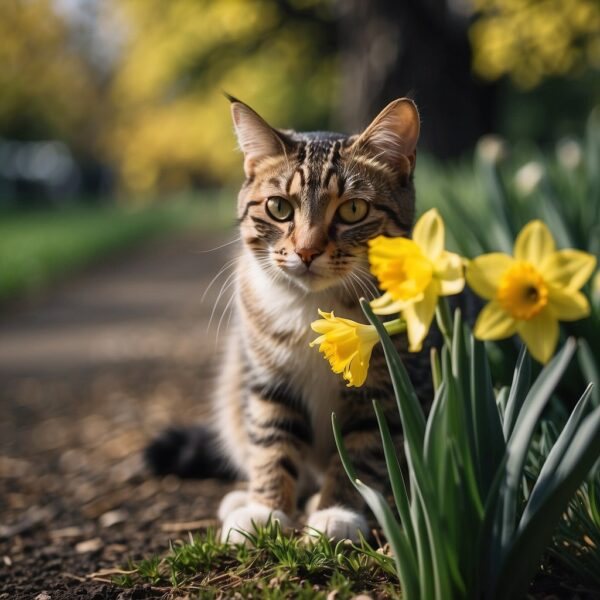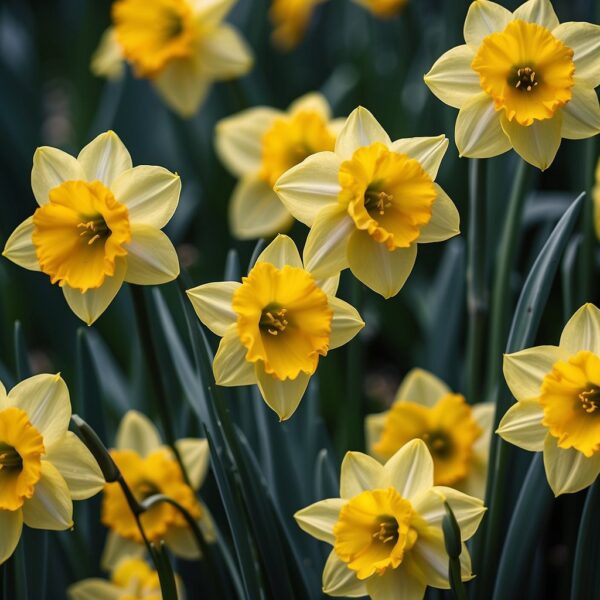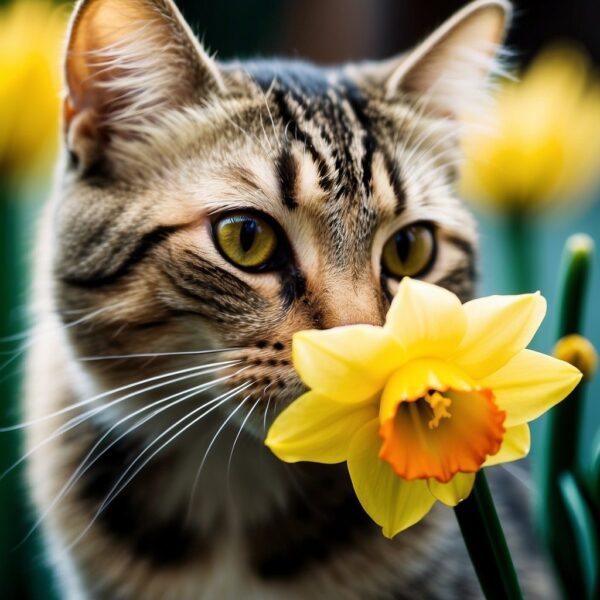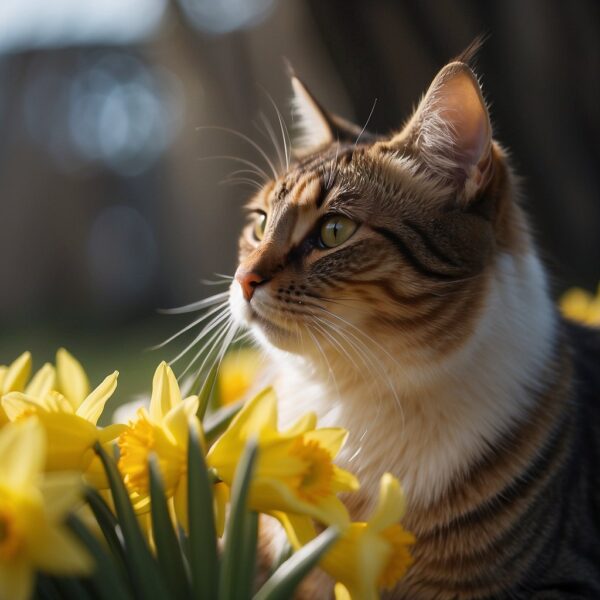
Are Daffodils Toxic to Cats: the Risks
Daffodils, with their bright blooms and rich history, are synonymous with the onset of spring. Often planted in gardens and showcased in homes, they bring joy and color after the long winter months. However, their presence raises serious concerns for cat parents. Are daffodils poisonous to cats? Beneath their cheery exterior lies a hidden danger to feline companions. The toxins present in daffodils, particularly the alkaloids and calcium oxalate crystals, are toxic to cats if ingested.
When a curious cat encounters a daffodil, the consequences can range from mild to severe. The entire daffodil plant is toxic to cats, with the bulb containing the highest levels of toxic substances. Encounters with daffodils may lead to symptoms such as vomiting, diarrhea, abdominal pain, heart arrhythmias, and in extreme cases, convulsions or serious systemic effects. It’s crucial for cat parents to recognize the risks and to know the steps to take should their cat come into contact with this plant.
Key Takeaways
- Daffodils contain toxins that are harmful to cats if ingested.
- Symptoms of daffodil poisoning in cats can range from mild gastrointestinal upset to severe neurological and cardiac issues.
- Prevention and awareness are critical for cat parents to protect their pets from daffodil toxicity.

Overview of Daffodils
The daffodil, also known as Narcissus, is a vibrant herald of spring in many gardens. It is known for its distinctive trumpet-shaped flowers, typically seen in shades of yellow or white.
Botanical Profile of Daffodils
Genus: Narcissus
Family: Amaryllidaceae
The genus Narcissus encompasses a group of plants predominantly spring-flowering that are easily recognized by their six petal-like tepals surmounted by a cup- or trumpet-shaped corona. Daffodils are perennial plants, oftentimes with bulbs that enable them to survive winter and reemerge every spring.
Natural Habitat:
Daffodils are native to meadows and woods in southern Europe and North Africa, with a center of diversity in the Western Mediterranean.
Growth and Cultivation:
They thrive in full to partial sunlight and prefer well-drained soils. The plant’s hardiness and longevity make it a staple in temperate gardens.
Common Varieties of Daffodils
Daffodils come in many varieties, classified by their distinct appearances. The most notable distinction can be made in the color and shape of their unique corona. Below are a few common varieties often spotted in gardens:
- Trumpet Daffodils: The classic variety with a long central trumpet and a ring of petals surrounding it. These are often brightly yellow but can come in white and other colors.
- Large-Cupped Daffodils: These have a prominent cup that is more than one-third the length of the petals but not as long as the trumpet’s.
- Small-Cupped Daffodils: As the name suggests, these have a smaller cup which is not more than one-third the length of the petals.
- Double Daffodils: Characteristic for their clustered cups and multiple layers of petals, giving them a ruffled, fuller appearance.
Each variety contributes its own charm to gardens and has added bursts of yellow and white to spring landscapes across many regions.

Dangers of Daffodils to Cats
Daffodils are poisonous to cats and pose serious health risks to cats, with all parts of the plant being toxic. When ingested, daffodils can trigger a range of adverse clinical signs, from gastrointestinal distress to potentially fatal systemic effects.
Toxic Parts of the Daffodil Plant
All parts of the daffodil plant contain toxic compounds, but the bulbs are especially poisonous to cats. If a cat ingests any portion of the daffodil—whether it be the bulb, flower, or even the water from a vase containing these plants—there is a risk for toxicity.
Symptoms of Daffodil Poisoning in Cats
Cats suffering from daffodil poisoning may exhibit a variety of symptoms, which usually appear within hours of ingestion. Common signs to look out for include:
- Gastrointestinal distress: vomiting, diarrhea, abdominal pain
- Respiratory issues: difficulty breathing, respiratory depression
- Neurological effects: tremors, convulsions, lethargy, seizures
- Cardiac abnormalities: heart arrhythmias, low blood pressure
- Additional signs: drooling, excessive salivation, dehydration, collapse
Immediate veterinary care should be sought if any of these symptoms are observed.
Toxic Compounds in Daffodils
Daffodils are poisonous to cats and contain several toxic alkaloids, with lycorine being the primary culprit responsible for the plant’s toxicity. This compound can cause a severe stomach upset, triggering vomiting and diarrhea. Additionally, calcium oxalate crystals found in daffodils can contribute to oral irritation and intense drooling upon ingestion.
First Aid and Treatment for Daffodil Poisoning
Upon suspecting daffodil poisoning in a cat, immediate steps need to be taken to mitigate the toxic effects while preparing for professional veterinary treatments that may be necessary.
Immediate Steps and Home Care
A cat parents’s first action should be to prevent the cat from ingesting any more plant material and to remove any remnants of the plant from the cat’s mouth, if safely possible. It is critical to avoid inducing vomiting without the advice of a vet or the pet poison helpline, as this can cause additional harm. Instead, providing water can help dilute the stomach contents.
- If the cat has already vomited, preventing dehydration is crucial.
- Do not administer any medication at home without explicit instruction from a veterinary professional.
Professional Veterinary Treatments
Immediate consultation with a vet is vital. The vet may decide to induce vomiting professionally if the cat has only recently ingested the daffodil. Activated charcoal may be used to absorb toxins, and the vet might administer intravenous fluids to combat dehydration and flush the toxins out more effectively.
- Medication to control symptoms like seizures may be provided.
- In severe cases, supportive care like oxygen or blood transfusions could be required.
- Always follow up with the vet for further care instructions post-treatment.

Preventing Daffodil Poisoning in cats
Protecting cats from the dangers of daffodil poisoning requires proactive steps in managing the immediate environment where cats live and play. Ensuring the garden or home remains safe for cats involves choosing non-toxic plants and maintaining a vigilant stance on preventing access to potential toxins.
Safe Gardening Practices
Starting with safe gardening practices, cat parents should take measures to prevent cat access to daffodils. These include:
- Securing Bulbs: Store daffodil bulbs in a secure location, away from cats and other pets, as bulbs contain higher concentrations of toxic substances.
- Physical Barriers: Erect fences or use enclosed flower beds to restrict pets from areas with daffodils planted.
- Regular Monitoring: Vigilantly monitor pets when they are outdoors, especially during the blooming season of spring flowers.
- Education and Awareness: Familiarize all family members with the symptoms of daffodil poisoning and have the Pet Poison Helpline (1-888-426-4435) easily accessible.
Cat-Friendly Plant Alternatives
When choosing cat-friendly plant alternatives for a cat-safe garden, consider incorporating the following which are generally regarded as non-toxic by the ASPCA:
- Orchids
- Roses
- Freesia
- Bromeliads
- Sunflowers
- Zinnias
Creating bouquets or garden spaces with these alternatives can provide a vivid splash of color without the associated risks of toxic plants like daffodils. Select plants that match the visual appeal of daffodils while ensuring the safety of pets.

Raising Awareness and Education
Educating cat parents and the community on the risks of daffodil poisoning in cats is a crucial step in preventing harm. Raising awareness about the toxicity of these common plants, with their scientific name being Amaryllidaceae, can save feline lives and prevent distress in families.
Role of Cat Parents and Community
Cat parents have a primary responsibility for keeping their cats safe from toxic plants like daffodils. Awareness starts with recognizing that daffodils are poisonous to cats and the potential danger that daffodils pose, as all parts of the plant are poisonous to cats. Parents need to:
- Review credible resources such as the ASPCA Animal Poison Control for accurate information.
- Ensure that daffodils are not accessible to their cats, both indoors and in gardens.
- Educate themselves on the symptoms of daffodil poisoning, which can include vomiting, diarrhea, abdominal pain, and more severe signs like tremors and lethargy.
The community’s role is to support cat parents by:
- Sharing information and experiences related to the toxic nature of daffodils.
- Promoting cat-safe gardening practices within neighborhood associations and local groups.
- Organizing educational programs in collaboration with veterinarians and animal welfare organizations to disseminate knowledge about poisonous plants and pet safety.
Other Animals and Daffodil Toxicity
Daffodils contain compounds that present a toxicity risk not only to cats but also to a wide range of animals, including common household pets and livestock.
Impact on Dogs and Other Household Pets
Dogs and other pets may suffer from daffodil toxicity if they ingest any part of the plant. Symptoms in dogs are similar to those in cats and can include:
- Vomiting
- Diarrhea
- Salivation
- Tremors
The toxic principles, such as lycorine and other alkaloids, are particularly concentrated in the bulbs of the daffodils. Ingesting the bulb can lead to more serious consequences, such as convulsions and cardiac arrhythmias.
Effects on Horses and Livestock
Horses exposed to daffodils can exhibit a host of clinical signs indicative of toxicity. These can range from mild to severe and include:
- Gastrointestinal upset (vomiting, diarrhea)
- Low blood pressure
- Cardiac irregularities
As with household pets, the most poisonous part of the daffodil for horses is the bulb. Livestock should be kept away from areas where daffodils are planted to prevent accidental ingestion, which could lead to the aforementioned symptoms and require veterinary intervention.
Frequently Asked Questions
Daffodils contain toxic alkaloids that are harmful to cats, and it’s important for cat parents to recognize symptoms and know the proper steps to take in case of ingestion.
What symptoms can occur if a cat ingests a daffodil?
If a cat ingests any part of a daffodil, they can exhibit symptoms such as vomiting, diarrhea, drooling, abdominal pain, and more severe symptoms like cardiac arrhythmias or central nervous system depression in extreme cases.
Which parts of the daffodil are harmful to cats?
All parts of the daffodil plant are toxic to cats, with the bulb being the most dangerous as it contains higher concentrations of toxic alkaloids.
What should I do if my cat has eaten part of a daffodil plant?
Immediate veterinary attention is crucial. If a cat has ingested daffodil, the guardian should not wait for symptoms to appear and should take the cat to a veterinarian immediately.
How can I safely display daffodils in a home with cats?
Daffodils should be displayed out of reach of cats or in an area where the cats do not have access. Consideration for cat-proof containers that prevent tipping or spilling can also be beneficial.
What are the treatments for daffodil poisoning in cats?
Treatment typically includes induced vomiting, administration of activated charcoal to prevent further absorption of toxins, and supportive care such as IV fluids, medications for symptom control, and monitoring of organ functions.
Are there any safe flowers similar to daffodils for households with cats?
While most lilies and bulb flowers are hazardous, cat parents can look for cat-safe alternatives like roses, sunflowers, and snapdragons to brighten their homes without the risk.